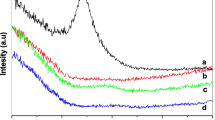Abstract
The present study investigated the effect of hybridisation on flexural strength and modulus of single-gated (SG) and double-gated (DG) injection moulded acrylonitrile butadiene styrene (ABS) polymer reinforced with both short glass fibres (GF) and spherical glass beads (GB). It was observed that flexural strength and modulus of SG and DG ABS/GF/GB hybrids increased with increasing the total concentration of the glass in the hybrid as well as the concentration of glass fibres in the hybrid (χf). Results indicated that hybrid flexural properties for both SG and DG mouldings obey the simple rule of mixtures. The presence of weldlines in DG mouldings had a negative effect on flexural properties. It was noted that weldline integrity factor (weld to unweld property ratio) for flexural modulus and strength decreased with increasing the total concentration of the glass in the hybrid. However, whilst weldline integrity factor for flexural modulus decreased with increasing χf, weldline integrity factor for flexural strength showed no significant variation with respect χf. Weldline integrity factors indicated that the hybrid flexural strength is more affected by the presence of weldline than the hybrid flexural modulus.











Similar content being viewed by others
References
Hashemi S, Gilbride MT, Hodgkinson JM (1996) J Mater Sci 32:5017. doi:https://doi.org/10.1007/BF00355900
Din KJ, Hashemi S (1997) J Mater Sci 32:375. doi:https://doi.org/10.1023/A:1018553400266
Chrysostomou A, Hashemi S (1998) J Mater Sci 33:1165. doi:https://doi.org/10.1023/A:1004365323620
Chrysostomou A, Hashemi S (1998) J Mater Sci 33:4491. doi:https://doi.org/10.1023/A:1004487814709
Nabi ZU, Hashemi S (1998) J Mater Sci 33:2985. doi:https://doi.org/10.1023/A:1004362915713
Hashemi S (2002) Plast Rubber Compos 31:1. doi:https://doi.org/10.1179/146580101125000484
Hashemi S, Lepessova Y (2007) J Mater Sci 42:2652. doi:https://doi.org/10.1007/s10853-006-1358-z
Necar M, Irfan-ul-Haq Khan Z (2003) J Mater Process Technol 142:247. doi:https://doi.org/10.1016/S0924-0136(03)00567-3
Fu SY, Lauke B, Mader E, Yue CY, Hu X (2000) Composites Part A 31:1117. doi:https://doi.org/10.1016/S1359-835X(00)00068-3
Fisa B (1985) Polym Compos 6:232. doi:https://doi.org/10.1002/pc.750060408
Thomason JL (2002) Compos Sci Technol 62:1455. doi:https://doi.org/10.1016/S0266-3538(02)00097-0
Thomason JL (2001) Compos Sci Technol 61:2007. doi:https://doi.org/10.1016/S0266-3538(01)00062-8
Yilmazer U (1992) Compos Sci Technol 44:119. doi:https://doi.org/10.1016/0266-3538(92)90104-B
Hashemi S, Elmes P, Sandford S (1997) Polym Eng Sci 37:45
Phillips LN (1976) Composites 7:7. doi:https://doi.org/10.1016/0010-4361(76)90273-1
Debondue E, Foumier J-E, Lacrampe MF, Krawczak (2004) J Polym Polym Compos 12:373
Sanschagrin B, Gauvin R, Fisa B, Vu-Khanh T (1990) J Reinf Plast Compos 8:194. doi:https://doi.org/10.1177/073168449000900209
Meddad A, Fisa B (1995) Polym Eng Sci 35:893
Akay M, Barkley D (1993) Plast Rubber Compos 20:137
Nadkarni VM, Ayodhya SR (1993) Polym Eng Sci 33:358
Hashemi S (2008) J Mater Sci. doi:https://doi.org/10.1007/s10853-007-2443-7
Cox HL (1952) Br Appl Phys 3:72
Einstein A (1906) Ann Phys 19:289. doi:https://doi.org/10.1002/andp.19063240204
Leidner J, Woodhams RT (1974) J Appl Polym Sci 18:1639. doi:https://doi.org/10.1002/app.1974.070180606
Author information
Authors and Affiliations
Corresponding author
Rights and permissions
About this article
Cite this article
Hashemi, S. Hybridisation effect on flexural properties of single- and double-gated injection moulded acrylonitrile butadiene styrene (ABS) filled with short glass fibres and glass beads particles. J Mater Sci 43, 4811–4819 (2008). https://doi.org/10.1007/s10853-008-2683-1
Received:
Accepted:
Published:
Issue Date:
DOI: https://doi.org/10.1007/s10853-008-2683-1




